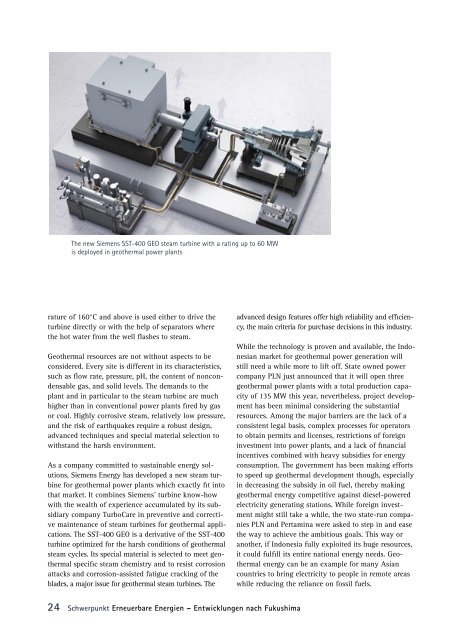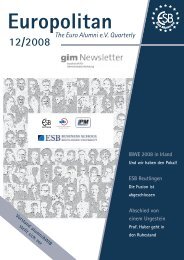Entwicklungen nach Fukushima - ESB-Radler
Entwicklungen nach Fukushima - ESB-Radler
Entwicklungen nach Fukushima - ESB-Radler
Erfolgreiche ePaper selbst erstellen
Machen Sie aus Ihren PDF Publikationen ein blätterbares Flipbook mit unserer einzigartigen Google optimierten e-Paper Software.
The new Siemens SST-400 GEO steam turbine with a rating up to 60 MW<br />
is deployed in geothermal power plants<br />
rature of 160°C and above is used either to drive the<br />
turbine directly or with the help of separators where<br />
the hot water from the well flashes to steam.<br />
Geothermal resources are not without aspects to be<br />
considered. Every site is different in its characteristics,<br />
such as flow rate, pressure, pH, the content of noncondensable<br />
gas, and solid levels. The demands to the<br />
plant and in particular to the steam turbine are much<br />
higher than in conventional power plants fired by gas<br />
or coal. Highly corrosive steam, relatively low pressure,<br />
and the risk of earthquakes require a robust design,<br />
advanced techniques and special material selection to<br />
withstand the harsh environment.<br />
As a company committed to sustainable energy solutions,<br />
Siemens Energy has developed a new steam turbine<br />
for geothermal power plants which exactly fit into<br />
that market. It combines Siemens’ turbine know-how<br />
with the wealth of experience accumulated by its subsidiary<br />
company TurboCare in preventive and corrective<br />
maintenance of steam turbines for geothermal applications.<br />
The SST-400 GEO is a derivative of the SST-400<br />
turbine optimized for the harsh conditions of geothermal<br />
steam cycles. Its special material is selected to meet geothermal<br />
specific steam chemistry and to resist corrosion<br />
attacks and corrosion-assisted fatigue cracking of the<br />
blades, a major issue for geothermal steam turbines. The<br />
24 Schwerpunkt Erneuerbare Energien – <strong>Entwicklungen</strong> <strong>nach</strong> <strong>Fukushima</strong><br />
advanced design features offer high reliability and efficiency,<br />
the main criteria for purchase decisions in this industry.<br />
While the technology is proven and available, the Indonesian<br />
market for geothermal power generation will<br />
still need a while more to lift off. State owned power<br />
company PLN just announced that it will open three<br />
geothermal power plants with a total production capacity<br />
of 135 MW this year, nevertheless, project development<br />
has been minimal considering the substantial<br />
resources. Among the major barriers are the lack of a<br />
consistent legal basis, complex processes for operators<br />
to obtain permits and licenses, restrictions of foreign<br />
investment into power plants, and a lack of financial<br />
incentives combined with heavy subsidies for energy<br />
consumption. The government has been making efforts<br />
to speed up geothermal development though, especially<br />
in decreasing the subsidy in oil fuel, thereby making<br />
geothermal energy competitive against diesel-powered<br />
electricity generating stations. While foreign investment<br />
might still take a while, the two state-run companies<br />
PLN and Pertamina were asked to step in and ease<br />
the way to achieve the ambitious goals. This way or<br />
another, if Indonesia fully exploited its huge resources,<br />
it could fulfill its entire national energy needs. Geothermal<br />
energy can be an example for many Asian<br />
countries to bring electricity to people in remote areas<br />
while reducing the reliance on fossil fuels.






